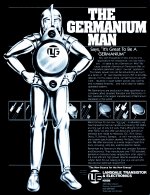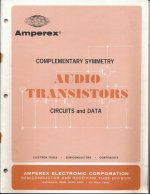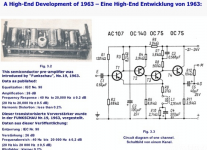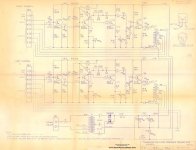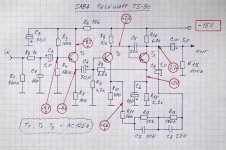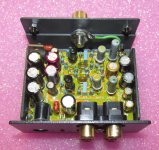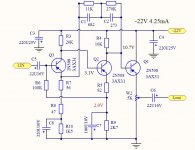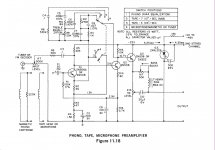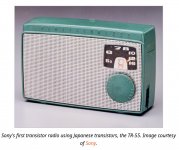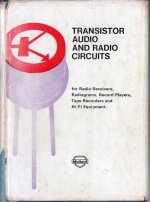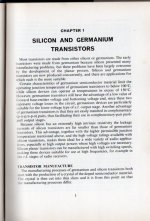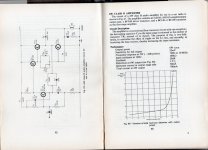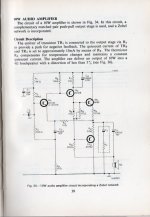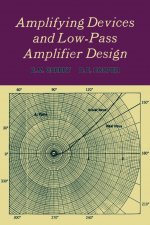Attachments
Phono 2N185 preamplifier https://ia801903.us.archive.org/6/i...Transistorized_Hi-Fi_Preamplifier_Aug1959.pdf
You can try find some equivalents of the original https://ia801904.us.archive.org/14/items/bitsavers_tidiscrete_1123234/2N185.pdf
Edit: Power Ge + https://ia803201.us.archive.org/10/...5132N514_13950654/2N511_2N512_2N513_2N514.pdf
You can try find some equivalents of the original https://ia801904.us.archive.org/14/items/bitsavers_tidiscrete_1123234/2N185.pdf
Edit: Power Ge + https://ia803201.us.archive.org/10/...5132N514_13950654/2N511_2N512_2N513_2N514.pdf
These days we also have Temperature controlled soldering iron and Low temperature bismuth solder.Special for Germanium soldering ...
Phono 2N185 preamplifier https://ia801903.us.archive.org/6/i...Transistorized_Hi-Fi_Preamplifier_Aug1959.pdf
I built many preamps using circuits just like this !!!
The third stage could be added to increase the gain or to add a microphone section.
Andy
These days we also have Temperature controlled soldering iron and Low temperature bismuth solder.
Thanks for the suggestion,
but low temperature bismuth solder is not my cup of tea, go for it if you like it.
My soldering station temperature is adjusted to the solder melting point, made hot and very quick soldering.
Use crocodile clip on the transistor lead to not overheat germanium chip is easy to implement solution for me.
Your choice is different and can be similarly good 🙂 Have a nice day
Hi 🙂
just to add nice Germaium RIAA circuit:
Germanium DIN Entzerrer auf RIAA trimmen, Analogtechnik/Plattenspieler - HIFI-FORUM
looks very interesting to me
just to add nice Germaium RIAA circuit:
Germanium DIN Entzerrer auf RIAA trimmen, Analogtechnik/Plattenspieler - HIFI-FORUM
looks very interesting to me
Attachments
Hi 🙂
just to add nice Germaium RIAA circuit:
It's certainly interesting but i have no idea what is "iec nr. 98". Are these standard time constants?
.
.
.4 transistors as opposed to 2 in the TI circuit
.More noise unless you choose them carefully
.
.
.4 transistors as opposed to 2 in the TI circuit
.More noise unless you choose them carefully
.
It's certainly interesting but i have no idea what is "iec nr. 98". Are these standard time constants?
Probably some of numerous LP eq-s? But I think that is not the big deal to exchange time constants within the pasive components to acheive stnadard riaa eq?
(I think that I am remember that I was checking circuit with spice and with silicium devices and EQ can be adjusted to riaa slope?)
Last edited:
RCA Victor & IEC No.98
refers to this "New Orthophonic" standard since 1952.
Recommendation of 1953 by NARTB, of 1955 by IEC No.98, and B.S. No. 128. World standard since 1964.
Time Constants: 3180 µs (50 Hz), 318 µs (500 Hz), and 75 µs (2,120 Hz).
TELDEC
Telefunken and Decca founded a record company that used a characteristic proposed for German DIN-Standard on July 1957: DIN45533, DIN45536, DIN45537.
Time Constants: 3180 µs (50 Hz), 318 µs (500 Hz), and 50 µs (3,180 Hz).
#366 Will work great on SI BJT.
refers to this "New Orthophonic" standard since 1952.
Recommendation of 1953 by NARTB, of 1955 by IEC No.98, and B.S. No. 128. World standard since 1964.
Time Constants: 3180 µs (50 Hz), 318 µs (500 Hz), and 75 µs (2,120 Hz).
TELDEC
Telefunken and Decca founded a record company that used a characteristic proposed for German DIN-Standard on July 1957: DIN45533, DIN45536, DIN45537.
Time Constants: 3180 µs (50 Hz), 318 µs (500 Hz), and 50 µs (3,180 Hz).
#366 Will work great on SI BJT.
Last edited:
The Amperex book is amusing. They boast about operating in class B instead of wasteful class A.
@ Astouffer
Yes but for consummer audio products, too lazy make heatsinks metal work..
This old Amperex book example makes build modern class A Ge amplifiers more interesting challenge.
Something to discovering or re-discovering in XXI Century
Yes but for consummer audio products, too lazy make heatsinks metal work..
This old Amperex book example makes build modern class A Ge amplifiers more interesting challenge.
Something to discovering or re-discovering in XXI Century

Translate the famous John Linsley-Hood's scheme to Germanium, at the output of GT806 and 1T813, changing the polarity in the scheme, a little finalizing you can get a wonderful sound. With amazing meander in 200 kHz.
Thanks for sharing and kind wordsOn my shelf is this old secondhand book published in 1969. I thought it may be of interest.
 Have a good time
Have a good timeThis sophisticated one + 1K pages included on the list. Public domain from Archive.org..Some of the older books still have good ideas.
Amplification with tubes and transistors, bunch of circuits examples and lots of deep knowledge..Highly recommended!
direct download : https://ia801904.us.archive.org/32/...s and Low-Pass Amplifier Design (1968)-RR.pdf
source:
Cherry, Hooper Amplifying Devices And Low Pass Amplifier Design ( 1968) RR : Free Download, Borrow, and Streaming : Internet Archive
Probably Papa book he was young student at University ?
Attachments
- Home
- Amplifiers
- Pass Labs
- Germanium investigations
